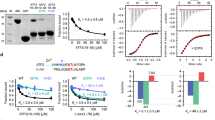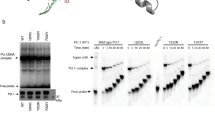Abstract
Activator protein 1 (AP-1) transcription factor dimers are composed of Jun, Fos, and ATF member proteins, but the mechanisms that determine AP-1 composition are not clearly defined and the function of specific dimers is not well understood. MEKK1 is a mitogen-activated protein kinase (MAPK) kinase kinase and an ubiquitin ligase that regulates both the extracellular signal-regulated kinase 1/2 and the c-Jun amino-terminal kinase. Herein, we demonstrate that MEKK1 regulates the AP-1 protein repertoire. Both FGF-2 and phorbol ester-inducible urokinase-type plasminogen activator (uPA) expression requires AP-1 binding to an enhancer element in the uPA promoter, and we have previously shown that FGF-2 or PMA induction of uPA expression is strongly dependent on MEKK1. JunB mRNA is significantly increased in MEKK1−/− cells, demonstrating that MEKK1 suppresses JunB mRNA expression. Upregulation of JunB expression in MEKK1−/− cells forms an inhibitory AP-1 complex that binds to the uPA promoter and inhibits uPA transcription. MEKK1 also regulates Fra-2 protein stability by inducing Fra-2 ubiquitination and degradation. MEKK1 regulates AP-1-dependent gene expression by regulating the expression, activity and degradation of component members of the AP-1 complex. Controlling the repertoire of a transcription factor complex is a newly defined function for an MAPK kinase kinase.
This is a preview of subscription content, access via your institution
Access options
Subscribe to this journal
Receive 50 print issues and online access
$259.00 per year
only $5.18 per issue
Buy this article
- Purchase on Springer Link
- Instant access to full article PDF
Prices may be subject to local taxes which are calculated during checkout






Similar content being viewed by others
References
Acquaviva C, Bossis G, Ferrara P, Brockly F, Jariel-Encontre I and Piechaczyk M . (2002). Ann. N Y Acad. Sci., 973, 426–434.
Acquaviva C, Ferrara P, Bossis G, Brockly F, Salvat C, Jariel-Encontre I and Piechaczyk M . (2001). Biochimie, 83, 357–362.
Andreasen PA, Kjoller L, Christensen L and Duffy MJ . (1997). Int. J. Cancer, 72, 1–22.
Angel P and Karin M . (1991). Biochim. Biophys. Acta, 1072, 129–157.
Angel P, Szabowski A and Schorpp-Kistner M . (2001). Oncogene, 20, 2413–2423.
Bakiri L, Lallemand D, Bossy-Wetzel E and Yaniv M . (2000). EMBO J., 19, 2056–2068.
Bakiri L, Matsuo K, Wisniewska M, Wagner EF and Yaniv M . (2002). Mol. Cell. Biol., 22, 4952–4964.
Behrens A, Jochum W, Sibilia M and Wagner EF . (2000). Oncogene, 19, 2657–2663.
Bugge TH, Lund LR, Kombrinck KK, Nielsen BS, Holmback K, Drew AF, Flick MJ, Witte DP, Dano K and Degen JL . (1998). Oncogene, 16, 3097–3104.
Casalino L, De Cesare D and Verde P . (2003). Mol. Cell. Biol., 23, 4401–4415.
Chiu R, Angel P and Karin M . (1989). Cell, 59, 979–986.
Cirillo G, Casalino L, Vallone D, Caracciolo A, De Cesare D and Verde P . (1999). Mol. Cell. Biol., 19, 6240–6252.
Collen D . (2001). Am. Soc. Hematol. Educ. Program, 2001, 1–9.
De Cesare D, Vallone D, Caracciolo A, Sassone-Corsi P, Nerlov C and Verde P . (1995). Oncogene, 11, 365–376.
D'Orazio D, Besser D, Marksitzer R, Kunz C, Hume DA, Kiefer B and Nagamine Y . (1997). Gene, 201, 179–187.
Eferl R, Sibilia M, Hilberg F, Fuchsbichler A, Kufferath I, Guertl B, Zenz R, Wagner EF and Zatloukal K . (1999). J. Cell Biol., 145, 1049–1061.
Fuchs SY, Dolan L, Davis RJ and Ronai Z . (1996). Oncogene, 13, 1531–1535.
Fuchs SY, Tappin I and Ronai Z . (2000). J. Biol. Chem., 275, 12560–12564.
Fuchs SY, Xie B, Adler V, Fried VA, Davis RJ and Ronai Z . (1997). J. Biol. Chem., 272, 32163–32168.
Jochum W, Passegue E and Wagner EF . (2001). Oncogene, 20, 2401–2412.
Kallunki T, Deng T, Hibi M and Karin M . (1996). Cell, 87, 929–939.
Karin M, Liu Z and Zandi E . (1997). Curr. Opin. Cell Biol., 9, 240–246.
Kesavan K, Lobel-Rice K, Sun W, Lapadat R, Webb S, Johnson GL and Garrington TP . (2004). J. Cell. Physiol., 199, 140–148.
Lamb JA, Ventura JJ, Hess P, Flavell RA and Davis RJ . (2003). Mol. Cell, 11, 1479–1489.
Legrand C, Polette M, Tournier JM, de Bentzmann S, Huet E, Monteau M and Birembaut P . (2001). Exp. Cell Res., 264, 326–336.
Lund LR, Bjorn SF, Sternlicht MD, Nielsen BS, Solberg H, Usher PA, Osterby R, Christensen IJ, Stephens RW, Bugge TH, Dano K and Werb Z . (2000). Development, 127, 4481–4492.
McHenry JZ, Leon A, Matthaei KI and Cohen DR . (1998). Oncogene, 17, 1131–1140.
Murakami M, Ui M and Iba H . (1999). Cell Growth Differ., 10, 333–342.
Musti AM, Treier M and Bohmann D . (1997). Science, 275, 400–402.
O'Hagan RC, Tozer RG, Symons M, McCormick F and Hassell JA . (1996). Oncogene, 13, 1323–1333.
Passegue E, Jochum W, Behrens A, Ricci R and Wagner EF . (2002). Nat. Genet., 30, 158–166.
Pepper MS . (2001). Arterioscler. Thromb. Vasc. Biol., 21, 1104–1117.
Roselli HT, Su M, Washington K, Kerins DM, Vaughan DE and Russell WE . (1998). Am. J. Physiol., 275, G1472–G1479.
Schorpp-Kistner M, Wang ZQ, Angel P and Wagner EF . (1999). EMBO J., 18, 934–948.
Shaulian E and Karin M . (2001). Oncogene, 20, 2390–2400.
Sternlicht MD, Lochter A, Sympson CJ, Huey B, Rougier JP, Gray JW, Pinkel D, Bissell MJ and Werb Z . (1999). Cell, 98, 137–146.
Szabowski A, Maas-Szabowski N, Andrecht S, Kolbus A, Schorpp-Kistner M, Fusenig NE and Angel P . (2000). Cell, 103, 745–755.
Thompson EJ, MacGowan J, Young MR, Colburn N and Bowden GT . (2002). Cancer Res., 62, 3044–3047.
Witowsky J, Abell A, Johnson NL, Johnson GL and Cuevas BD . (2003). J. Biol. Chem., 278, 5941–5946.
Witowsky JA and Johnson GL . (2003). J. Biol. Chem., 278, 1403–1406.
Yang BS, Hauser CA, Henkel G, Colman MS, Van Beveren C, Stacey KJ, Hume DA, Maki RA and Ostrowski MC . (1996). Mol. Cell. Biol., 16, 538–547.
Young MR, Farrell L, Lambert P, Awasthi P and Colburn NH . (2002a). Mol. Carcinogen., 34, 72–77.
Young MR, Nair R, Bucheimer N, Tulsian P, Brown N, Chapp C, Hsu TC and Colburn NH . (2002b). Mol. Cell. Biol., 22, 587–598.
Yujiri T, Sather S, Fanger GR and Johnson GL . (1998). Science, 282, 1911–1914.
Yujiri T, Ware M, Widmann C, Oyer R, Russell D, Chan E, Zaitsu Y, Clarke P, Tyler K, Oka Y, Fanger GR, Henson P and Johnson GL . (2000). Proc. Natl. Acad. Sci. USA, 97, 7272–7277.
Zenz R, Scheuch H, Martin P, Frank C, Eferl R, Kenner L, Sibilia M and Wagner EF . (2003). Dev. Cell, 4, 879–889.
Author information
Authors and Affiliations
Corresponding authors
Rights and permissions
About this article
Cite this article
Cuevas, B., Uhlik, M., Garrington, T. et al. MEKK1 regulates the AP-1 dimer repertoire via control of JunB transcription and Fra-2 protein stability. Oncogene 24, 801–809 (2005). https://doi.org/10.1038/sj.onc.1208239
Received:
Revised:
Accepted:
Published:
Issue Date:
DOI: https://doi.org/10.1038/sj.onc.1208239
Keywords
This article is cited by
-
Identification of rheumatoid arthritis and osteoarthritis patients by transcriptome-based rule set generation
Arthritis Research & Therapy (2014)
-
Differential regulation and properties of MAPKs
Oncogene (2007)
-
Role of mitogen-activated protein kinase kinase kinases in signal integration
Oncogene (2007)
-
MEKK1 controls matrix degradation and tumor cell dissemination during metastasis of polyoma middle-T driven mammary cancer
Oncogene (2006)



